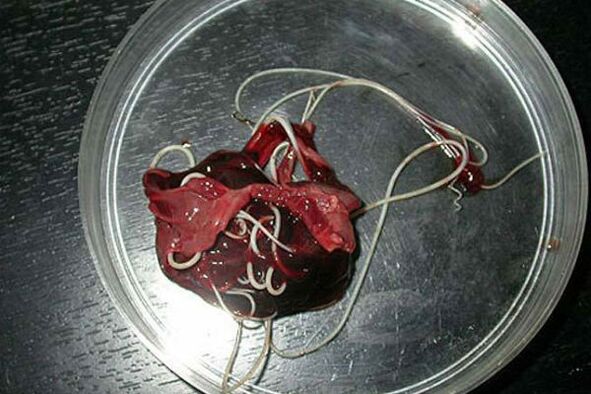
Worms in humans, the symptoms and treatment of which will be prompted by a doctor, are caused in humans by two types of worms - round (nematodes) and flat (flukes and tapeworms). Each parasite can cause significant harm to the body, especially if proper treatment is not provided in a timely manner.
Be sure to wash your hands when you get home, and rinse vegetables or fruits in lukewarm or hot water, as parasite eggs are likely to be found on them. Products such as fish or beef must be heat-treated. Under the action of high temperature, the meat gets rid of the eggs of various worms and is suitable for consumption.
various roundworms
Pinworms are small, grayish-white parasitic flatworms that awaken pinworms.
Such parasites enter the body in the following ways:
- the digestive tract (through the mouth);
- Pass unwashed/dirty hands.
Pinworm eggs are found in unwashed fruits or vegetables, or in the fur of sick animals. Children who scratch the itchy area of the skin and then swallow eggs (for example, along with contaminated food) are more likely to get pinworms. It takes two weeks for pinworm larvae to develop in the environment of the digestive tract, and when fully developed, a mature worm lives in various parts of the large intestine.
Trichinella - These parasites have round bodies no more than 5 mm long and cause trichinosis in the body. Larvae and eggs prefer to be in poorly fried meats (wild boar, pork, bear meat). In humans, adult Trichinella worms take up to 4 days and their life cycle is 40 days. The main purpose of this worm is to enter the bloodstream through the intestinal wall and settle in the muscles. In addition, the muscles of the respiratory and musculoskeletal systems are often affected.
Roundworms are representative of large size, with spindle-shaped reddish-yellow tints. Males of this species reach a size of 15-25 cm and females up to 40 cm. Their bodies don't have any adaptations to be fixed in the gut, they just move through the gut independently into the food block.
Ascaris can be infected by swallowing mature eggs while eating unwashed vegetables or fruits, which are left with the smallest soil particles. After the eggs enter the human internal environment, adult larvae hatch from them, terrorizing the intestinal wall. Through the blood, the parasite can reach the heart muscle and then the lungs.

Only then the circulation through the body does not end, as the larvae enter the mouth through the respiratory tract.
By re-swallowing the parasite, the body has created a favorable environment for its development.
The route of a mature worm will pass through the small intestine. Their life cycle is 12 months, after which they die and are excreted in feces.
Vlasoglavy - worm in humans, the symptoms and treatment of which can be determined at any time after infection, prefers to live directly in the gut. This worm eats blood components or feeds on the intestinal mucosa.
Females lay eggs directly on the walls of the affected organs, and they come out with the feces and develop under environmental conditions. A mature larva whose body is oblong and does not exceed the limit of 5-15 mm. into the human digestive tract.
These parasites have round bodies no more than 5 mm in length and provoke trichinosis in the body. Larvae with eggs are found in poorly fried meat (wild boar, pork, bear meat).
In humans, adult Trichinella worms take up to 4 days and their life cycle does not exceed 40 days. The main purpose of this worm is to enter the bloodstream through the intestinal wall and settle in the muscles. In addition, the muscles of the respiratory and musculoskeletal systems are often affected.
Hookworm / Hookworm. The link between these parasites is direct and related to the diseases and biological signs they cause. They live in the duodenum and due to their small size (10-15 mm), they move freely in their surroundings.
If a person has been exposed to contaminated soil, the larvae can only enter the body through the skin. Another target of the worms is the lungs and digestive tract. They feed only on the blood that flows from the blood vessel they are bitten on. Due to the vigorous activity of these parasites, blood clotting is disturbed. Adults consume 0. 1-0. 35 ml of blood per day.
various flatworms

Wide Ribbon. The parasite has a body length of 10-20 meters and deserves attention.
Parasites originate in freshwater fish and crayfish, with larvae entering eggs and fillets.
It takes up to 25 days for adult worms to form, and then a person develops dilobites (disturbed digestive tract, B-vitamins deficiency).
Liver flukes are a type of flatworm that can reach 10-20 mm in size, another name for this parasite - cat fluke. In 50% of infections, residents who eat infected fish (carp, crucian carp, snapper, cockroaches) are affected. The fish became infected with liver flukes by eating snails that had previously consumed the worm eggs in fresh water.
To remove the parasites from the fish, heat treatment is necessary, otherwise the larvae can enter the internal environment and damage the gallbladder and intestines. Signs of the acute phase of the development of helminthiasis in humans are nausea, which turns into vomiting, upper abdominal pain, allergic reactions, and muscle cramps. Parasites cause irreversible changes in the body, and even after they are excreted from the patient, various inflammations and diseases are sure to occur.
Pork/Bovine Tapeworms. The parasite is 5-6 meters long, and its larvae hide in the meat of large animals (pork, cattle). The diseases caused by these worms are called teniasis and teniarinhoz.
The larvae of two tapeworm species Finn are white vesicles that attach to the wall of the small intestine. It takes 3 months for the parasites to reach and form adults, and the worms develop every day. The total number of segments reaches 2000, and finally the large intestine is free to "ditch".
The worms then leave the body through the anus along with the feces. The most common and obvious symptoms of helminthiasis are disturbances in the digestive tract, as well as a large intake of food, and the patient has no visual weight gain.
Echinococcus tapeworm. In this case, a person acts as an intermediate host because the ultimate hosts are wolves, cats, dogs. Animals can become infected through direct contact with contaminated objects or people. As soon as the parasite's eggs enter the gut, six-hooked larvae, medically known as balloons, develop immediately.

The worm's favorite habitats are the lungs and liver, and the larvae become hydatid cysts that grow in size. All tissue in close proximity to it is subject to rapid destruction.
Doctors often do not detect echinococcosis and confuse it with malignant or benign. In addition to squeezing blood vessels and internal organs, hydatid cyst rupture is also common.
If this happens, not only is there an immediate toxic shock in the body, but the ruptured cyst can trigger the formation of several new cysts.
The last of these parasites is Pneumococcus, which is called Echinococcus in the medical literature. It is this worm that awakens a terrible disease, causing harm commensurate with cancer and cirrhosis. The worm's balloon enters the intestine, whereupon the embryo hatches from the egg and begins to destroy the intestinal wall. After the walls are drilled, the parasite enters the bloodstream and spreads throughout the body.
As mentioned, in most cases, pneumococcus terrorizes the larvae's growing liver. During development, larvae form in worms - an aggressive formation (multi-lumen vesicles, which grow gradually) that rapidly increases in size. These vesicles enter hepatocytes on the same basis as cancerous metastases.
Nearby tissue feels a violation of blood flow, followed by necrotic changes. Fibrous knots with such multi-cavity blisters form on nearby structures, and they can remain in the body for years. That's why doctors resort to surgical intervention when this parasite is detected.
notes
Modern science knows about 280 species of worms. It is these microorganisms that can parasitize and develop in various tissues and organs of the human body.
Each year, these worms in humans, the symptoms and treatment of which are determined by doctors, affect the organs and tissues of approximately 15 million people, the majority, or 80 percent of them, children.
How to get worms:
- Use poorly heat-treated meat dishes or regular raw meat. So, beef is a tapeworm habitat, and pork carries pork tapeworms.
- Eat brackish or raw infected fish. River water is often contaminated with worm larvae.
- Water can also cause worms. This is because a person can drink raw water, or use contaminated water to wash food, dishes. The risk is especially high when outdoors.
- Soil can also cause worms to appear. Because it can contain animal or human feces. But how do worms get into the human body? The answer is simple - not washing your hands after garden or outdoor recreation.

Also, you can become infected through direct contact with someone with helminthiasis. That is, infection occurs through dishes, sheets, or personal hygiene items.
If the case is completely ignored and the parasitic infection is in the acute phase of its development, then doctors prescribe detoxification and desensitization therapy. If the disease is very difficult, glucocorticoids are prescribed.
When it comes to specific treatments, it takes into account the nature of the pathogen and involves special chemotherapeutic agents with anthelmintic properties.
In addition, patients are advised to take various antihistamines. At the end of treatment, you will need to take a course of probiotics. All of this is necessary to restore the gut flora. During treatment, patients must adhere to a special diet that includes foods that are easy to digest and have minimal fat content.
It is very important to adhere to impeccable personal hygiene during treatment, otherwise there is a risk of re-infection.
In addition, all family members, as well as others who have frequent close contact with the patient, should be treated with deworming.
Signs of Human Worms: Symptoms in Children and Adults
In adults and children, signs of human worms can be observed in sharp form, and the symptoms may be the same:
- Loss of appetite, excessive drooling, and rapid weight loss.
- Another variant of symptom development can also occur - loss of appetite and nausea after eating.
- Perhaps the appearance of headaches and dizziness.
- Loose stools or constipation may also indicate the presence of worms.
- abdominal pain.
- A sudden onset of incomprehensible allergy symptoms.
- Hair and nails become weaker (their fragility increases due to lack of iron and vitamin B12).
- Various inflammations occur in the nasopharynx and genital area due to a weakened immune system.
If the body is severely infected with worms, a large amount of toxic substances appearing due to the life activity of the worms are released into the human blood. This condition can greatly affect a child's health. First, the nervous system is damaged. Therefore, children should be checked for worms if they show signs of sudden aggression, irritability, insomnia, and other neurological disturbances.

Even if there are no obvious signs and no dysfunction, worms can exist in the human body, so regular testing is needed to identify them.
It often happens that after a preventive vaccination, children develop allergic reactions due to the presence of toxic substances secreted by the worms in the body.
In fact, judging the presence of worms based on only superficial signs is quite a difficult task. After all, the symptoms shown may be a sign of another disease. This task is especially difficult for pregnant women. With all the signs of human worms mentioned above, the symptoms of which appear in pregnant women are due to the process itself.
For this reason, signs of a worm infection in pregnant women can be distinguished by the following symptoms: itching in the anus and burning in the vaginal area, nighttime gain, weight loss, fatigue, fever.
To diagnose a worm infection, a number of steps are taken, including the following procedures:
- Collect medical records to identify possible sources of infection.
- Stool and blood, rectal and perianal mucus, muscle tissue, sputum and bile samples are studied in the laboratory. While performing these activities, signs of the presence of worms in the body (eggs or the worms themselves, and their sites) can be detected. It is also worth noting that an increase in the number of eosinophils can serve as a marker for the presence of worms in the body.
- Serological studies (ELISA, RSK, etc. ) can detect the presence of parasites in larval or worm stages living in muscle tissue.
- To determine the presence of parasites affecting the liver, ultrasound, CT and endoscopy are prescribed.
Worms in the Human Liver: Symptoms of Worm Types
Worms in the human liver, whose symptoms depend largely on the type of worm, can also migrate to other organs.
The main signs of a worm infection don't appear right away. In many respects, the timing of the appearance of distinctive features depends on the species composition of the parasite. Thus, the presence of roundworms for almost two to three days manifests as a deterioration of a person's general condition.
In most cases, the first symptoms of infection with other types of worms begin to appear only two to three weeks after the incubation period ends. Some parasites, such as filariasis, have an incubation period of more than six months.
The problem with determining whether worms are present in humans is that in the case of a small number of worms or the initial infection of a single individual, there are few visual signs. Symptoms begin only after the worms have proliferated or reached large size (taeniasis, roundworms).
The most reliable way is to identify a pinworm infection. In their presence, the characteristic itching of the anus develops, which intensifies at night. Basically, the itching occurs within a few days, then subsides for about two weeks and returns again.
It occurs when infected with helminths such as trichomoniasis, trichomoniasis, schistosomiasis, dilobites, beriberi, and anemia.
The appearance of symptoms of roundworm infection depends largely on the developmental stage of the parasite. Therefore, if they are in the initial stages of development, the larvae move through the bloodstream to almost all internal organs and develop symptoms of the disease: hypothermia, weakness, cough with purulent sputum, volatile exudate visible on X-ray. lungs, which subsequently disappeared.
Severe infections can progress to bronchitis and pneumonia. With the further development of the parasite, the function of the gastrointestinal tract is violated.
Trichinosis - Mainly manifested by pain, fever, and swelling of the muscle tissue.
This worm in the human liver, with symptoms of jaundice, such as fascioliasis, keratomiasis, clonorchiasis, shows their presence with an increase in the spleen and liver and other serious diseases of the body.
Nearly all types of worms can cause central nervous system disturbances, and while patients experience severe headaches and fatigue, normally calm individuals become irritable and impatient, and unreasonably aggressive aggression may occur.






































